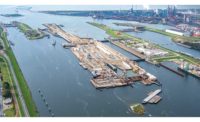The state of Texas has a seemingly unquenchable thirst for water, and Kansas City, Mo.-based general contractor Garney Construction seemingly has endless resources to supply it.
Although active throughout Texas, Oklahoma and Louisiana, the water/wastewater contractor primarily focuses on Texas because of its steady population growth, says David Burkhart, director of central pipe operations with Garney. The firm, 100% employee owned with a workforce of 1,500, likewise is growing. Its regional revenue has nearly doubled—from $164.4 million to $308.66 million—from 2015 to 2018.
Operating in four Texas offices—Houston, San Antonio, Midland and Leonard, a city near Dallas—the 58-year-old enterprise provides services ranging from pipe, plant and pump stations to tanks, sitework and heavy civil for both public entities, including federal, state and municipal agencies, and private companies, including industrial enterprises, says Burkhart.
“We’re unique in that we bring a full range of services to clients,” says Mark Kelly, Garney’s director of business development. Further, says Burkhart, the firm has resources to self-perform nearly all work, with the exception of tunneling, paving and electrical controls.
“Many water contractors self-perform on smaller projects,” says Kelly. “We self-perform on projects ranging in value from $500,000 to $500 million because it gives us greater control over quality, cost and schedule.”
“Other firms practice CMAR, but none with the proficiency of Garney.”
– Cesar Baptista, Assistant Deputy for Engineering and Construction, North Texas Municipal Water District
For instance, the firm concurrently worked on a $23.15-million pump station for the city of McKinney, Texas, and an ongoing $717-million pipe and plant project in Fannin County for Wylie-based North Texas Municipal Water District (NTMWD), due for completion in 2022. Among other components, the Fannin projects, dubbed Bois d’Arc Lake, includes a 280-million-gallon-per-day (mgd) greenfield water treatment plant, two 70 mgd pump stations, a water storage tank and 65 miles of 90-in. and 84-in. water lines.
The firm’s Texas offices share resources depending on the needs of a given project. “If our Leonard office lands a significantly sized project involving large-diameter pipe, it may call upon management and craftsmen from our other Texas offices to assist in completing the work,” says Burkhart. “We’re very flexible that way. Depending on the project, resources from other regions also may contribute if needed.”
A focus on delivery methods that promotes early collaboration between owner and builder, including construction management at-risk (CMAR), design-build and progressive design-build, has further contributed to Garney’s growth, says Burkhart. Among other distinctions, Garney completed the first alternative delivery project in Texas in 2007, implementing CMAR to construct a $6-million Market Street Pump Station along San Antonio’s Riverwalk, Burkhart adds.
As more states and municipalities have come to recognize the value of alternative delivery methods, Garney has honed its expertise in such methods for Texas-based clients including San Antonio Water System, the city of McKinney, Dickinson-based Gulf Coast Water Authority and NTMWD. “Other firms practice CMAR, but none with the proficiency of Garney,” says Cesar Baptista, assistant deputy for engineering and construction with NTMWD.
By allowing the builder to participate during initial planning stages, owners benefit from their insight involving constructibility, cost, schedule and quality, which ultimately provides owners with greater control over the project, says Kelly. The result, as often as not, is repeat business, as has occurred with NTMWD.
“If we’re implementing a complex and difficult project, one of the first lines of thought is working with Garney,” says Baptista.
The two first joined forces in 2007, when NTMWD hired Garney to construct a $17.4-million pipeline in Lake Tawakoni, Texas, under a design-bid-build contract. Five years later, the pair broke ground on NTMWD’s first CMAR project, the $281.5-million Lake Texoma Outfall to Wylie Water Treatment Plant Pipeline, recalls Baptista. A $102.8-million pump station and pipeline project followed in Rosser, Texas, in 2016. The Bois d’Arc Lake project, leveraging Garney’s expertise in both plant and pipeline, has further cemented the relationship, Baptista says.
“Our project management teams and field services teams have developed strong working relationships with their project management and field services teams,” says Baptista. “Working with them on pipelines, and now plants, it’s become clear their culture is rooted in consistent commitment to owner needs.”
To complete the Bois d’Arc Lake plant, Garney’s Leonard operations recruited expertise from the firm’s Houston office. Among other attributes, the Houston contingent, new to NTMWD, “exhibits the same dedication to quality, schedule and budget,” says Baptista. “You even see it in the firm’s younger employees, who are smart, capable and strategic in their thinking. That’s a tribute to management—the training they receive from the top down.”
“Employees excel because the company is 100% employee owned,” Burkhart contends. “I believe that provides a sense of pride and responsibility that inspires us to achieve very high levels of quality and efficiency.” Pride of ownership also trickles into areas such as safety, he says. The firm currently boasts an experience modification rate of 0.49 and a total case incident rate of 1.31, with 3.2 million hours worked in 2018.
“The ability to self-perform further enhances our safety performance, given safety is such an essential part of our culture,” says Burkhart. Extensive training is supported by initiatives that include daily huddles, job hazard analyses and use of safety task analysis cards that remind contractors of potential hazards during a day’s activities.
Of late, the firm has extended its expertise in the realm of public-private partnerships (P3s). After cutting its teeth on smaller projects, Garney is serving as developer on the $927-million Vista Ridge Water Supply Project, an undertaking that will supply 20%—or 50,000 acre-ft per year—of demand for San Antonio Water System (SAWS), says Scott Parrish, Garney president. It also is the largest P3 water project in North America, he says.
When completed next year, Vista Ridge will include 140 miles of transmission pipeline, including 54-in.-dia and 60-in.-dia bar-wrapped and steel pipe, three pump stations, each with rated capacities of 52 mgd, a cooling tower, 18 wells drilled into an aquifer, seven miles of well collection lines, three 4-million-gallon concrete tanks and one 10-mg concrete tank.
The delivery method is design-build, with the San Antonio offices of Pape-Dawson Engineers and CP&Y serving as designers and Garney as builder for the project’s well field, transmission line, pump stations and terminus. Once construction concludes, Phoenix-based EPCOR USA will operate the water system with funds derived by water payments from SAWS.
Likewise, the revenue source required to service the project’s debt will be paid for by funds derived from water payments by SAWS over a period of 30 years. Thereafter, project assets will transfer to SAWS, according to Parrish.
For Garney, “The optimal construct for P3 is when it can be both private equity and engineering, procurement and construction contractor,” says Parrish. “This structure has proven very efficient.”
Garney holds a majority equity position in the Vista Ridge project.
P3 contracts in the water/wastewater industry remain rare, in part due to a lack of education about how P3 works, Parrish says. “There also needs to be specific variables that make the P3 the optimal project approach for both the private and public sector,” he says. “Project development risk transfer as well as off-balance financing are benefits to the end-user, such as municipalities. P3 concessioners can develop a long-term cash flow that can result in benefits beyond normal construction returns. For us, the P3 is just another tool in our toolbelt.”








